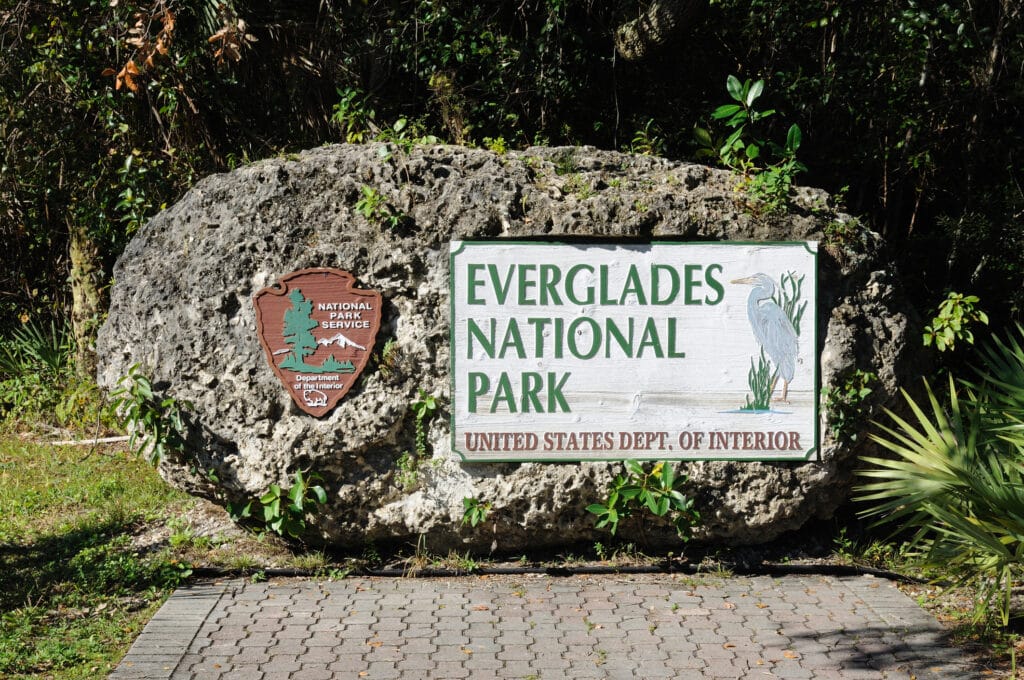
Everglades National Park is open year-round, 24 hours a day. The main Homestead entrance (near Florida City) and the Everglades City entrance on the Gulf Coast operate 24/7, while the Miami entrance at Shark Valley is open to vehicles from 8:30 AM to 6:00 PM (after 6 PM its road closes to cars, though visitors can still enter on foot or bicycle). An entrance pass costs $35 per vehicle (valid for seven consecutive days for all park entrances).
Other options include $30 per motorcycle or $20 per person if arriving on foot, bike, or by boat; children 15 and under enter free. If you plan to visit often, the park’s annual pass costs $70, and the nationwide America the Beautiful annual pass (covering all US national parks) is $80. Special passes allow free or discounted entry for U.S. military members, veterans, seniors (age 62+ can obtain lifetime passes), and even for families with 4th grade children. We visited on 01 August 2025, and all figures were valid then.
All About Everglades National Park: What to See & Expect
Established in 1947, Everglades National Park was the first national park created to protect an ecosystem rather than a geological marvel. Its 1.5 million acres of wetlands are often nicknamed the River of Grass – a vast, slow-moving sheet of water flowing from Lake Okeechobee to Florida Bay through sawgrass prairies, mangrove forests, and cypress swamps. Did you know this is the only place on Earth where alligators and crocodiles coexist in the wild? We were amazed by that unique fact. The park’s diverse habitats support an incredible range of wildlife: hundreds of bird species (from roseate spoonbills to great blue herons), elusive Florida panthers prowling the pine rocklands, manatees grazing in the coastal shallows, and more. Many of these creatures are endangered, so protecting this subtropical wilderness is critical.
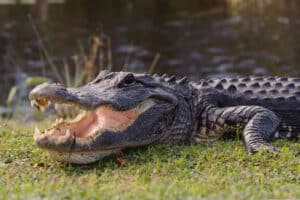
Alligator in Everglades park in Florida.
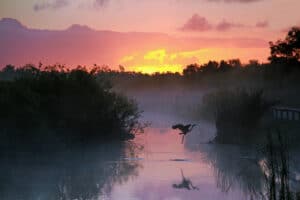
Everglades National Park at Sunrise with the Silhouette of a Flying Heron
Natural Features & Ecology
The landscape is extremely flat (mostly just a few feet above sea level) with a limestone bedrock, which creates a mosaic of habitats from freshwater sloughs to brackish mangrove estuaries. We learned that seasonal cycles dominate here. In the dry winter season (November–March), water levels drop and wildlife congregates around wetlands – making it the best time for bird watching and hiking, with relatively fewer mosquitoes. By contrast, the wet summer season (April–October) brings heavy rains, rising water, and hordes of insects (trust us, you’ll want repellent in July!). Still, our summer visit offered lush green scenery and dramatically fewer tourists on the trails.
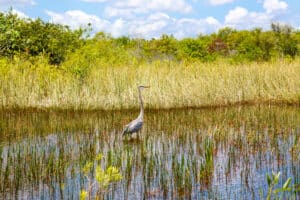
Airboat ride at Everglades National Park in USA
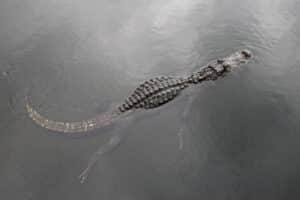
American alligator swimming in a lake, top view, Everglades National Park, Florida, USA.
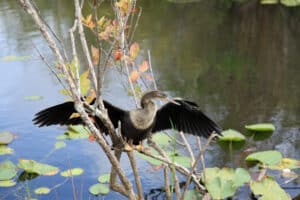
Anhinga bird at Everglades National Park.
The park’s rangers and scientists manage these ecosystems with care – even using controlled fires in the prairies to mimic natural cycles and maintain habitat health. An ambitious multi-decade Everglades restoration project is underway to improve water flow after past decades of drainage; we saw signs of ongoing work like new bridges along the Tamiami Trail, all aimed at reviving the wetlands.

Everglades airboat in South Florida, National Park
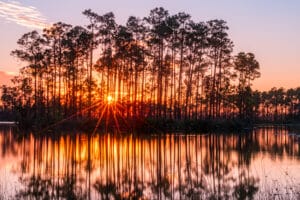
Sunset in the everglades of florida
Park Highlights & Trails
With such an expansive area, what’s the best way to explore it? We found that each park entrance leads to different experiences. From the Homestead side, we drove the main park road down to Flamingo, a coastal outpost where the freshwater glades meet the Gulf of Mexico. Along the way, we stopped to walk the famous Anhinga Trail, a short boardwalk loop where we spotted wild alligators and colorful anhinga birds sunning themselves just feet away from us. (It felt safe since we were on an elevated platform!)
We also strolled the Gumbo Limbo Trail under a canopy of tropical hardwood trees, which was shady and serene. Another highlight was climbing the observation tower at Shark Valley (the Miami entrance area). It’s about a half-mile walk or bike ride from the parking area to the tower, but the panoramic view from the 45‑foot high platform was worth it – endless sawgrass marsh stretching to the horizon. We spent two days in the park and felt it was barely enough; if you love nature, you could easily linger for several days discovering its far corners, though many visitors just do a day trip from Miami.
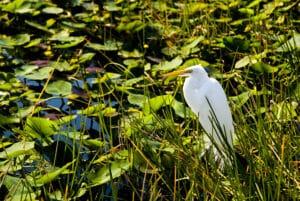
White bird at Everglades National Park with lily pads background.
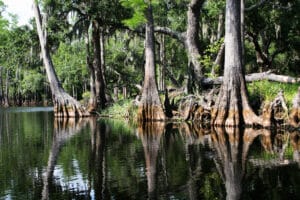
Swamp forest. A serene shot of a swamp in the everglades national park Florida
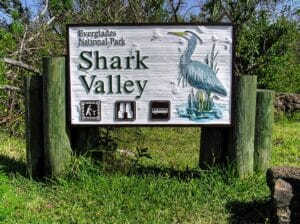
Shark Valley sign board in Everglades National Park.
Trails, Food Stops & Local Attractions
Beyond the main hotspots, we discovered plenty of side adventures and local flavors around Everglades National Park:
-
Scenic Trails & Canoe Routes: In addition to the popular boardwalks, we enjoyed less crowded paths like the Mahogany Hammock Trail (a boardwalk through an eerie forest of giant mahogany trees and airplants) and the Pa-hay-okee Overlook which offered a peaceful vista over the grasslands at sunset. Kayaking or canoeing is another fantastic way to experience the glades – we paddled a short loop on the Nine Mile Pond canoe trail, gliding between mangrove islands and sawgrass meadows, which felt quiet and magical. At the Gulf Coast entrance near Everglades City, we joined a guided boat tour among the Ten Thousand Islands mangrove maze and even saw dolphins play in our wake.
-
Wildlife Viewing Tips: Early morning was the ideal time for wildlife. We woke up before dawn to hit the trails around 7 AM; it was cool, quiet, and we watched wading birds feeding actively in the marshes. We’d definitely recommend that strategy. The park never felt crowded except around some midday tour spots, and we didn’t encountered any heavy crowds since we explored some smaller trails on our own. (One pro tip: the visitor centers have wildlife sighting boards – checking those helped us plan where to go.)
-
Local Eateries & Rest Stops: After long hours outdoors, we were pretty hungry and ready to relax. For lunch one day, we drove into the small gateway town of Everglades City and ate at Camellia Street Grill, a funky waterfront spot. It served super fresh stone crab claws and grouper tacos – basically a Florida seafood feast on a patio by the river. Another evening, near the Homestead entrance (south of Miami), we stopped by Everglades Gator Grill. It was a casual roadside eatery where we even tried fried alligator bites (because when in Florida, you might as well sample the gator!) alongside classic burgers; the meal turned out surprisingly tasty. On our way back from the park, we also swung by the famous Robert Is Here farm stand in Florida City. They made the best tropical fruit milkshakes we’ve ever had (mango and key lime was a delicious combo) and sold local honey and jams – a perfect sweet treat after a hot day exploring. We left happily with a jar of guava jelly as a souvenir.
-
Other Attractions Nearby: If you have more time, we suggest visiting Big Cypress National Preserve, which borders the Everglades to the north. We drove a portion of the scenic Loop Road through Big Cypress and saw an astonishing number of alligators lurking in the roadside canals. For a different vibe, the Florida Keys are not far either – in fact, the road to Flamingo in Everglades NP begins just a short hop from the highway down to Key Largo. Some travelers in our group were gonna continue south to the Keys right after our Everglades trip, combining two iconic South Florida destinations in one go.
Our journey through Everglades National Park gave us a deeper appreciation for the resilience and richness of this unique wilderness. We navigated between sawgrass plains and cypress domes, marveled at the coexistence of ancient reptiles, and even tasted a bit of the local culture just outside the park. At every turn, we learned something new – about the land’s history, its delicate balance, and how even so close to a major city, wild nature still thrives. We ended our trip a bit sun tired, a tad bug-bitten, but full of respect and wonder for this one-of-a-kind place.
Sorry, there were no items that matched your criteria.

